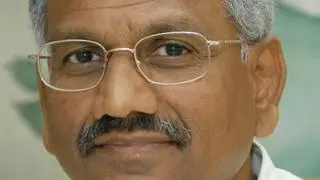A scientist of Indian descent, who was honoured with a Padma Shri by Indian government some years ago, and his colleagues in the US have shown that a key metabolic activity in the human cell can be manipulated from outside, making it possible to have a therapy for many incurable diseases.
In a paper published in the journal Nature Biotechnology on Monday, the scientists, led by Vamsi Mootha, a professor of systems biology at Harvard Medical School, reported engineering of a protein that can reduce the build-up of electrons in the mitochondria, the powerhouse of the cells.
Mootha, also an investigator at the Howard Hughes Medical Institute, was honoured with India's fourth highest civilian award in 2014.
Correcting metabolic dysfunctions
“In normal course, our body’s cells will strip electrons from the food we eat — and they are conveyed into the mitochondria ultimately to oxygen. In the process energy is harvested to enable our cells to function,” said Anupam Patgiri, a post-doctoral fellow at Mootha's lab and the first author of the research paper.
This electron transfer from food to oxygen, taken in through respiration, is mediated by a class of molecules called nicotinamide adenine dinucleotide, or NAD, which shuttles between its two forms — NADH (electron donor) and NAD+ (electron acceptor), he said.
“We’re finding that mitochondrial diseases lead to many electrons ora highNADH/NAD+ ratio,which results in subsequent cellular pathology (disease condition). This new therapeutic concept helps to dissipate disease-associated build-up of electrons so that normal function within the cell can resume,” said Patgiri, who hails originally from Assam.
The focus of the scientists is very rare paediatric and neurological diseases that affect one in 5,000 births. This condition, what scientists call reductive stress, is interestingly associated with multiple common disorders such as age-related neuro-degenerative diseases (Parkinson’s disease and Alzheimer’s disease), ischemia-reperfusion, and the aging process itself. It is hard to get a number of people affected by metabolic diseases, Patgiri, who did his masters in chemistry at the Indian Institute of Technology Guwahati, before heading to New York University to complete his PhD.
“This is a new type of a therapy, where we are trying to fix the metabolism inside of the cell by directly targeting the chemicals entering and exiting the cell from the outside of the cell. Therefore, this strategy will allow us to inject the enzyme into blood to correct metabolic dysfunctions within the organs. It’s a new therapeutic concept,” Patgiri told BusinessLine .
According to him, there is a possibility that the enzyme that they designed might have some beneficial effects in diabetes as an elevated NADH/NAD+ ration has been found in diabetic cases too. “However, this is just a hypothesis,” Patgiri clarified.
As a next step, Mootha’s team would try to produce the protein, which they engineered by infusing two bacterial proteins, on scale. They would also need to improve the protein properties so it is not prone to degradation and so it does not elicit an immune response. “The biotech sector has figured out how to overcome these challenges — they are engineering problems — and if overcome, we’ll be able to do additional preclinical testing in animals. And if those look promising, we hope to then advance to human (trials). But we have a lot of work to do still," said Patgiri.







Comments
Comments have to be in English, and in full sentences. They cannot be abusive or personal. Please abide by our community guidelines for posting your comments.
We have migrated to a new commenting platform. If you are already a registered user of TheHindu Businessline and logged in, you may continue to engage with our articles. If you do not have an account please register and login to post comments. Users can access their older comments by logging into their accounts on Vuukle.